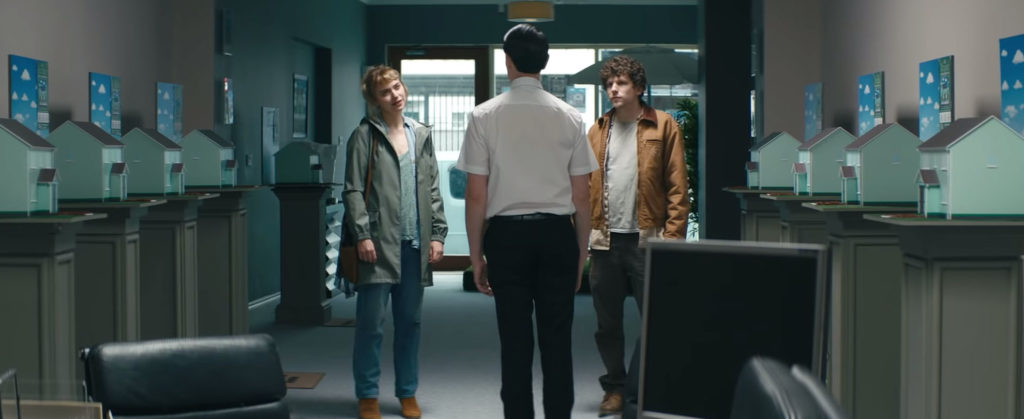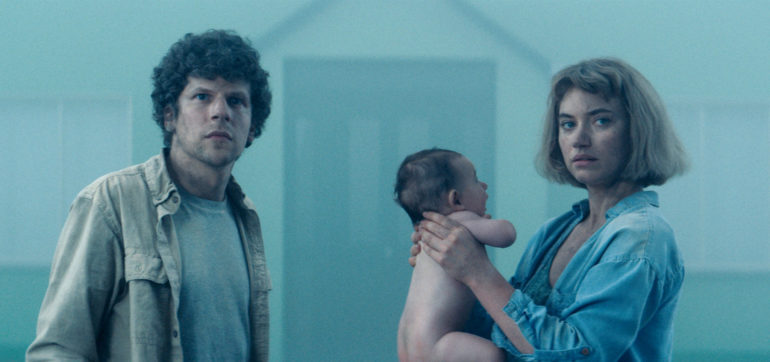Great films stand the test of time; most films tend to age like fruit. Rarer still is those films which grow into new meanings as they mature. Vivarium is one such film. The film – whose cinema release date has been scrapped due to Covid-19 pandemic and will now stream on VOD – seems eerily prescient about the conditions in which it’ll be released. Irish households are, at this moment, understandably feeling a whole flux of emotions: bored, agitated, anxious, a little on edge, vulnerable, sick of the deluge of small, petty family feuds from spending an abnormal amount time together. Vivarium dramatizes all these feelings and more. This is a sci-fi inflected haunted house film in which the ghosts are those who you live with and the horrors are the banalities of middle-class life seen through a glass darkly.
The film starts with young couple Gemma and Tom’s (Imogen Poots and Jesse Eisenberg) search to purchase their first house. Martin, an alienlike estate agent whose smile and twitches are as hilarious as they are unnerving, brings the couple to Yonder; a newly-developed, currently desolate housing estate of sickly green-houses and a place devoid of wind and a real sky (an inexplicable painterly one stands in its place). Abandoned by Martin, unable to escape the off-kilter suburban labyrinth that they find themselves, Gemma and Tom are forced to settle down in Yonder where they begin to raise a rapidly developing humanoid baby of sorts who is mysteriously left at their door…
If Vivarium sounds a little mad it’s because it is – and all in the best kind of way. From it’s opening shot of cuckoo eggs hatching, all set to a buzzing, anxious score as the opening credits roll, Vivarium is cryptically letting you know what you’re in for. Lorcan Finnegan exerts a masterful level of control over all elements of his sophomore feature. Vivarium, with its small cast of five and its minimum amount of settings, remains ambitious though stripped back and is utterly brilliant. The film is bareboned but strange-skinned, boasting an idiosyncratic visual style and a level of genre hybridity rarely scene. It’s a kaleidoscope of different genres, encompassing elements of sci-fi, horror, comedy, thriller, and, more specifically, the surreal, the absurd – the intimations are endless. But the film never seems clunky or trapped within these genres as they all serve the same purpose: dissecting the disgust and disappointment which plague many people as they move into middle-age. Vivarium is deliciously dark, and it knows it.

In interviews, Finnegan speaks of the multiple sources from which Vivarium was torn from – a Frankenstein method of creation – finding inspiration from sources as broad as Magritte’s Empire of Life to a David Attenborough documentary on the European cuckoo. Such variety results in a film that’s visually daring and full of bold, fascinating ideas. This coalescing technique characterizes much of the film. The acting is terrific – Imogen Poots injects emotion and existential complexity into every scene with ease while Eanna Hardwicke clearly has a blindingly bright future ahead of him – but what makes it so impressive is the way Finnegan offsets the naturalism of Poots and Eisenberg against the elevated otherness of Hardwicke or Jonathan Aris’ (Martin, the real estate agent) performances. The clashes between these two styles result in scenes with a tangible tension to them.
If there is a problem – and there is but it’s only slight – it’s that the film’s allure resides primarily in its strangeness and its shifting unpredictability. Such effects fade unless rejuvenated with even more of the unexpected: it suffers from the inexorable entropy of the weird and the eery. The film doesn’t get as deliriously crazy towards its end as it seems to want to and as it needs to. The opening third to the film remains its strongest as it is it’s most alive because, perhaps unavoidably, it is its most surprising – the latter third could do with an injection of some surreal adrenaline. But this complaint is a minor one. It’s a relief that films as hard to categorize as Vivarium are still being made. All (two) of Finnegan’s feature films have a political dynamic to them: 2016s superb Without Name deals with our relationship to nature while the abandoned housing estates of Vivarium are faintly reminiscent of Ireland’s construction landscape after the 2008 financial crash. It is only a testament to the strength and the strangeness of the film that in the context of Covid-19 it seems to be garnering new resonances. When you’re playing with so many styles, genres and influences you’re bound to make art that transcends its makers’ given intentions – and Vivarium is certainly that.

